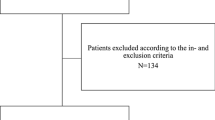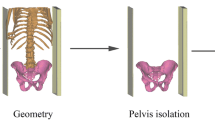Abstract
Purpose
The aim of this study is to describe the influence of sitting and standing posture on sagittal pelvic inclination in total hip replacement patients to assist with correct acetabular component positioning.
Methods
Lateral radiographs of the pelvis and lumbar spine in sitting and standing positions were extracted. Pelvic tilt was measured using the vertical inclination of a line from the anterior superior iliac spine (ASIS) to pubic tubercle. Sacral inclination, Cobb angle of the lumbar spine and hip flexion were recorded.
Results
Sixty patients were identified with a mean age of 63. Men were more likely to flex the lumbar spine in sitting (p = 0.004); 80° of hip flexion is required for seated posture. Stiff hips required compensatory pelvic flexion and lumbar flexion in sitting. There is a linear relationship between hip flexion and pelvic tilt, hip flexion and lumbar lordosis.
Conclusions
Pelvic orientation is determined by lumbar and hip stiffness. This impacts on acetabular version.



Similar content being viewed by others
References
Fortina M, Carta S, Gambera D, Crainz E, Ferrata P, Maniscalco P (2005) Recovery of physical function and patient’s satisfaction after total hip replacement (THR) surgery supported by a tailored guide-book. Acta Biomed 76(3):152–156
AOA (2013) Australian Orthopaedic Association National Joint Replacement Registry. Annual Report. Adelaide
Walter WL, Insley GM, Walter WK, Tuke MA (2004) Edge loading in third generation alumina ceramic-on-ceramic bearings: stripe wear. J Arthroplasty 19(4):402–413
Walter WL, O’Toole GC, Walter WK, Ellis A, Zicat BA (2007) Squeaking in ceramic hips: the importance of acetabular component orientation. J Arthroplasty 22(4):496–503
Sexton SA, Yeung E, Jackson MP, Rajaratnam S, Martell JM, Walter WL, Zicat BA, Walter WK (2011) The role of patient factors and implant position in squeaking of ceramic-on-ceramic total hip replacements. J Bone Joint Surg Br 93(4):439–442
Lewinnek G, Lewis J, Tarr R, Compere C, Zimmerman J (1978) Dislocations after total hip-replacement arthroplasties. J Bone Joint Surg Am 60(2):217–220
Murray DW (1993) The definition and measurement of acetabular orientation. J Bone Joint Surg Br 75(2):228–232
DiGioia AM, Mahmoud AH, Jaramaz B, Levison TJ, Moody JE (2006) Functional pelvic orientation measured from lateral standing and sitting radiographs. Clin Orthop Relat Res 453:272–276
Tang WM, Chiu KY (2000) Primary total hip arthroplasty in patients with ankylosing spondylitis. J Arthroplasty 15:52–58
Archbold HA, Mockford B, Molloy D, McConway J, Ogonda L, Beverland D (2006) The transverse acetabular ligament: an aid to orientation of the acetabular component during primary total hip replacement: a preliminary study of 1000 cases investigating postoperative stability. J Bone Joint Surg Br 88(7):883–886
Maruyama M, Feinberg JR, Capello WN, D’Antonio JA (2001) The Frank Stitchfield Award: morphologic features of the acetabulum and femur: anteversion angle and implant positioning. Clin Orthop Relat Res 393:52–65
Sotereanos NG, Miller MC, Smith B, Hube R, Sewecke JJ, Wohlrab D (2006) Using intraoperative pelvic landmarks for acetabular component placement in total hip arthroplasty. J Arthroplasty 21(6):832–840
Yoshimine F (2006) The safe-zones for combined cup and neck anteversions that fulfill the essential range of motion and their optimum combination in total hip replacements. J Biomech 39(7):1315–1323
Biedermann R, Tonin A, Krismer M, Rachbauer F, Eibl G, Stöckl B (2005) Reducing the risk of dislocation after total hip arthroplasty: the effect of orientation of the acetabular component. J Bone Joint Surg Br 87:762–769
Siebenrock KA, Kalbermatten DF, Ganz R (2003) Effect of pelvic tilt on acetabular retroversion: a study of pelves from cadavers. Clin Orthop Relat Res 407:241–248
McCollum DE, Gray WJ (1990) Dislocation after total hip arthroplasty. Causes and prevention. Clin Orthop Relat Res 261(22):159–170
Bozic KJ, Kurtz SM, Lau E, Ong K, Vail TP, Berry DJ (2009) The epidemiology of revision total hip arthroplasty in the United States. J Bone Joint Surg Am 91(1):128–133
Lazennec JY, Rousseau MA, Rangel A, Gorin M, Belicourt C, Brusson A, Catonné Y (2011) Pelvis and total hip arthroplasty acetabular component orientations in sitting and standing positions: measurements reproducibility with EOS imaging system versus conventional radiographies. Orthop Traumatol Surg Res 97:373–380
Blondel B, Parratte S, Tropiano P, Pauly V, Aubaniac JM, Argenson JN (2009) Pelvic tilt measurement before and after total hip arthroplasty. Orthop Traumatol Surg Res 95:568–572
Coventry MB, Beckenbaugh RD, Nolan DR, Ilstrup D (1974) 2,012 total hip arthroplasties. A study of postoperative and early complications. J Bone Joint Surg Am 56:273–284
Barrack RL, Lavernia C, Ries M, Thornberry R, Tozakoglou E (2001) Virtual reality computer animation of the effect of component position and design on stability after total hip arthroplasty. Orthop Clin North Am 32:569–577
Wines AP, McNicol D (2006) Computed tomography measurement of the accuracy of component version in total hip arthroplasty. J Arthroplasty 21(5):696–701
Wolf A, Digioia AM 3rd, Mor AB, Jaramaz B (2005) Cup alignment error model for total hip arthroplasty. Clin Orthop Relat Res 437:132–137
Parratte S, Pagnano MW, Coleman-Wood K, Kaufman KR, Berry DJ (2009) The 2008 Frank Stitchfield Award: variation in postoperative pelvic tilt may confound the accuracy of hip navigation systems. Clin Orthop Relat Res 467:43–49
Eilander W, Harris SJ, Henkus HE, Cobb JP, Hogervorst T (2013) Functional acetabular component position with supine total hip replacement. Bone Joint J 95-B:1326–1331
Acknowledgments
This study did not require industry or hospital funding. Support was provided by the Specialist Orthopaedic Group practice in terms of electronic hardware and software.
Conflict of interest
The authors declare that they have no conflict of interest.
Author information
Authors and Affiliations
Corresponding author
Rights and permissions
About this article
Cite this article
Stephens, A., Munir, S., Shah, S. et al. The kinematic relationship between sitting and standing posture and pelvic inclination and its significance to cup positioning in total hip arthroplasty. International Orthopaedics (SICOT) 39, 383–388 (2015). https://doi.org/10.1007/s00264-014-2491-y
Received:
Accepted:
Published:
Issue Date:
DOI: https://doi.org/10.1007/s00264-014-2491-y




